A much demonised whale is about to reappear at cinemas worldwide in a new movie, In the Heart of the Sea, but this classic representation of whales as horrible threatening beasts is more fiction than fact. Whilst it is understandable that early humans were frightened by the immense size of the whales, the deliberate depiction of the whale as a monster took hold in the years of open sail-boat or Yankee whaling, which started around the 1730s. In its hey-day, such whaling spanned the globe to harvest the valuable oil found in the heads and bodies of the great whales. Returning home after their long and often highly lucrative journeys, whalers told stories of battling huge and fierce whales that no doubt boosted the men's reputations. Indeed, the whales may also have acted as scape-goats when vessels or goods were lost at sea through human error.
So it was that the legend of the great white monster-whale Moby Dick was born. This famous fiction by Herman Melville was based in part on the real story of the Whaleship Essex, which was struck and sunk by a whale in 1820. Whilst In the Heart of the Sea released in December, is mainly focused on what befell the poor shipwrecked crew who suffered months of terrible deprivation, including some cannibalism, it will also feature the 'monster whale' again. So, how do such portrayals of whales match the reality?


Illustration from 'The Leisure Hour' published in 1862
The species concerned in the Essex's demise is the sperm whale, whose head contains what was once the most valuable of oils, and no-one knows them better than Professor Hal Whitehead of Dalhousie University. He has spent the better part of his life studying these animals and is the author of many scientific papers and books, including 'Sperm whales - social organisation in the ocean.' A seminal book that does for sperm whales what Dr Jane Goodall's 'The Chimpanzees of Gombe' did for the chimpanzees, it translates the sophisticated behaviour and societies of sperm whales for our species to understand. We can no longer be ignorant of who they are!
In the account of the Whaleship Essex sinking, written by first mate Owen Chase and published in 1831 in New York, the crew is actively engaged in whaling when the mother-ship, the Essex, is struck by a whale. The whale hits the boat once and then again more strongly and the bow is broken, or in the language of the day, 'stove-in'. The Essex was an old vessel in poor condition and it's important not to over-estimate its robustness, so I asked Hal if it was likely that a whale would attack a whaling vessel. He said that in the many years he had been studying them at sea he had never encountered whale aggression. Instead, they are rather 'timid' and 'easy upset'. Hal also points to Thomas Beale, a ship's physician on whaling vessels, who published his account of sperm whale biology in 1839. He too found them timid rather than aggressive, counter to other more fanciful publications of the same day.
Indeed, when threatened by natural predators, sperm whales typically form a protective circle, with vulnerable calves at the centre. Given the whale's famously large brain, I also asked Professor Whitehead if the whales might have learnt how to avoid the whalers. He said that some could have, and those that dived away, and swam in the direction that the wind was coming from (which a sailing vessel would find it difficult to follow), had a good chance of escaping. It is also possible that a fleeing whale might just collide with a whale boat.
Hal also commented that a whale's response is significantly determined by what he or she has witnessed other whales do. Hal explains "These are very social animals, probably more social in many senses than we are! They are nomadic but what is constant for them is the group, and social learning affects almost all parts of whale behaviour (as it does humans). This applies to how they respond to whalers as well as to more natural threats. How a whale would respond to something like the Whaleship Essex would depend on what she has learnt from others, and may differ between different groups."
So the sperm whale, far from being an aggressive giant of the sea, is in fact a non-threatening, highly-social animal with advanced cognitive and communications skills that typically lives within close-knit social groups. The legend of Moby Dick gives a false impression of the nature of whales, and both ancient and modern depictions of whales as fearsome, are largely human artifice. Most of us know better, but it is nevertheless true that the 'demon whales' continue to suit the propaganda of current day commercial whalers who mercilessly hunt and kill magnificent ocean leviathans in direct defiance of a global moratorium.
In a case brought by Humane Society International, Australia's federal court just last week found Japanese whaling company Kyodo Senpaku Kaisha guilty of contempt of court for killing whales in the Australian Whale Sanctuary and fined them $1millionAUS. Despite this and the International Court of Justice ruling that found Japan's previous whale killing in Antarctica illegal, Japan plans to resume whaling there this Christmas. High level diplomatic action is needed from all whale-friendly nations, including Britain, to persuade the whaling nations to desist.
Together with 11 other conservation and welfare organisations, HSI recently launched a petition urging the UK government to do just this. If you care about the whales and you are a UK citizen or live in the UK, please sign and share the petition to get your voice heard.